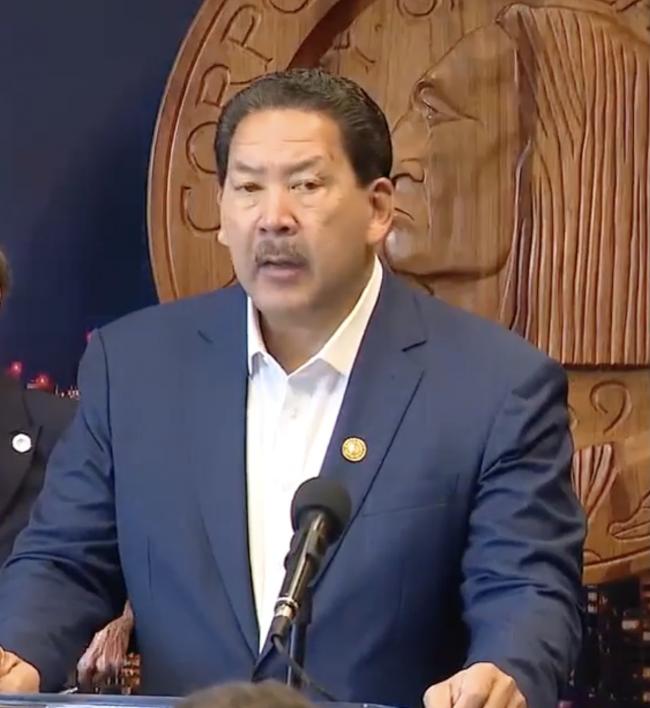Seattle unveils groundbreaking police contract, enabling major CARE expansion and strengthening accountability
Seattle Mayor Bruce Harrell led a press conference at City Hall to announce major changes to the CARE department, making it the "Third pillar" of law enforcement for the city.
Wed, 10/22/2025
Mayor Bruce Harrell's administration announced a tentative collective bargaining agreement (CBA) with the Seattle Police Officers Guild (SPOG) today, marking a "pivotal moment" in the city’s public safety strategy. The four-year contract, which covers salaries and working conditions through 2027, transitions the Community Assisted Response and Engagement (CARE) Department from a limited pilot into a permanent, expanded entity with the authority for crisis responders to be solo dispatched to thousands of emergency calls.
The agreement, which the SPOG membership ratified over the weekend, also incorporates significant police accountability measures and offers wage and benefit improvements designed to boost officer recruitment and retention.
"This groundbreaking agreement with rank-and-file officers represents a pivotal moment in our efforts to reimagine the public safety paradigm," Mayor Harrell stated, noting that the contract unlocks the full potential of the CARE model by removing staffing limits and allowing direct dispatch.
CARE Department Becomes Third Pillar of Public Safety
The key feature of the new contract is the removal of limitations on CARE’s Community Crisis Responder (CCR) staffing, which was previously capped at 24. CCRs are now authorized for solo dispatch to low-acuity 9-1-1 calls, including those related to reports of a person in a behavioral health crisis, requests for shelter or resources, and welfare checks. The city is scaling up to 48 responders available nearly around the clock next year.
CARE Chief Amy Barton called the agreement the "most significant milestone" since the pilot launched, stating that going forward, the department will "finally be able to predictably and consistently send the best first response to a 911 call".
When asked by media about what happens after a CARE team responds and how people are directed into services, Chief Barton explained that the role is focused on immediate stabilization and referral:
“This is not long-term case management. They’re not meant to be outreach workers,” Chief Barton clarified. She emphasized that the goal is to hand off individuals to the behavioral health system, nonprofits, emergency housing, and ultimately to reduce reliance on jails, focusing on "building out that what would be the voluntary system".
Responding to a question regarding the use of coercive care, Chief Barton was explicit about the roles of the departments:
“I again, I’m always very specific that law enforcement is always going to be the coercive team. That’s not going to be CARE. But I also know that we do very, very rarely refer anyone involuntarily into services,” she noted.
Accountability Reforms Streamlined
The new CBA delivers significant accountability reforms, aligning the disciplinary timeline calculation with the 2017 Accountability Ordinance, addressing a major concern of the federal monitor and U.S. District Court Judge James Robart.
The agreement also introduces a streamlined process allowing supervisors (sergeants) to address minor performance issues directly, empowering them to impose discipline. Mayor Harrell’s Chief of Staff, Andrew Meyerberg, clarified the types of issues that will now be handled at the sergeant level instead of the Office of Police Accountability (OPA):
“it would be minor performance issues. Um you know, you you parked your car in the wrong zone and there was a community complaint. Um you are repeatedly late to work... they are better suited to be handled at the chain of command level,” Meyerberg explained.
For serious cases, the agreement empowers the OPA to assign civilian investigators as co-lead investigators on cases involving potential termination.
However, the City reached an impasse with SPOG on several key disciplinary appeal reforms outlined in the Accountability Ordinance, necessitating interest arbitration. Mr. Meyerberg detailed the issues heading to arbitration:
“the same elements of the SPMA disciplinary review system. So as you may recall, it’s burden of proof, so preponderance of the evidence. It is the no gotcha rule... it would be arbitrary and capricious [standard for overturning discipline]... and it would also be we don’t want denovo investigation,” he said.
Compensation and Recruitment Boost
The contract increases wages and benefits to help Seattle remain competitive in hiring among West Coast cities. Officers will receive a 6% retroactive pay increase for 2024 and 4.1% for 2025. The costs for the roughly $130 million four-year contract are included within the city’s proposed budget and do not require new funding.
When asked about the new starting salary for officers, Mayor Harrell and staff confirmed:
“I believe this is 118,000 will be the starting,” the Mayor stated.
The agreement also incentivizes higher education and multilingual skills, aligning with the 2017 accountability ordinance. New premiums include 4% for a bachelor’s degree, 1.5% for an associate degree, and 1.5% if an officer qualifies for a multilingual language premium.
Police Chief Shon Barnes noted that the department has hired 152 new officers this year (134 entry-level and 17 lateral hires), calling it the most significant hiring seen in years. Chief Barnes stressed that the focus remains on outreach and trust, especially in neighborhoods most affected by violence. When addressing a question about the department’s message to community members most impacted by crime, Chief Barnes responded:
“My answer is is really really simple. Number one, we will be communicating to you our efforts to establish trust. We must we must be able to communicate to our community what we’re doing to keep them safe,” Chief Barnes asserted.
He added that the department has implemented an evidence-based "Seattle policing" strategy, stratifying significant incidents like homicides and robberies to identify patterns and allocate resources proactively.


